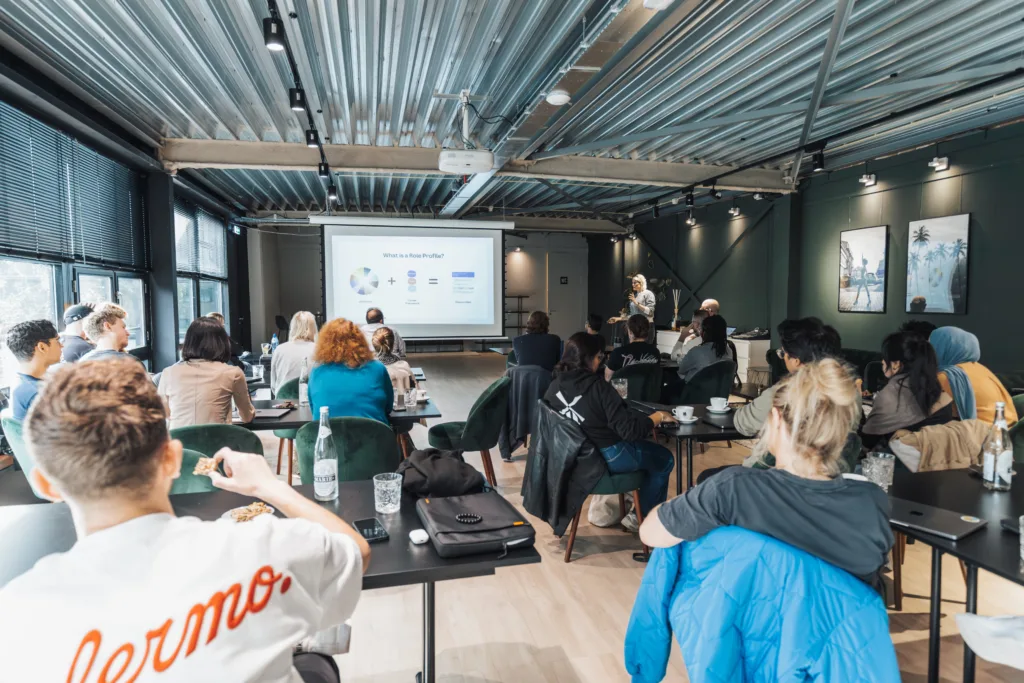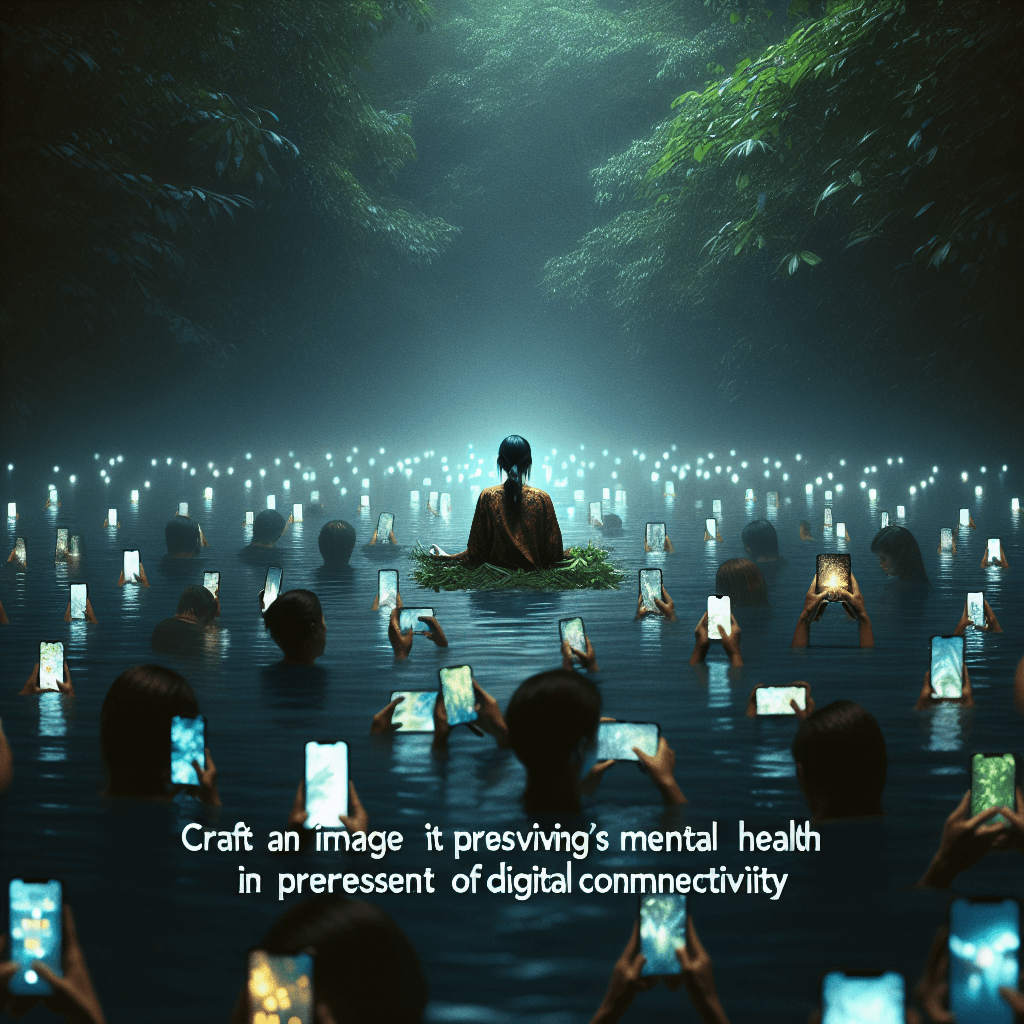In today’s fast-paced world, characterized by constant digital connectivity, it has become increasingly challenging to maintain mental well-being. The constant stream of notifications, emails, and social media updates can easily overwhelm and exhaust even the most resilient individuals. This article discusses the importance of prioritizing mental health in an age dominated by technology, and offers practical tips and strategies to help you navigate the digital landscape while preserving your mental well-being. From setting boundaries to practicing mindfulness, these techniques can empower you to regain control and find balance amidst the digital chaos.
Table of Contents
Understanding the Impact of Digital Connectivity on Mental Health
Definition of digital connectivity
Digital connectivity refers to the degree to which individuals are connected to and reliant on digital devices and technology. In today’s technologically advanced world, digital connectivity has become increasingly pervasive, with people constantly connected to their smartphones, tablets, computers, and other digital devices. This connectivity enables individuals to stay connected with others, access information, and perform various tasks more efficiently. However, the excessive and constant use of digital devices can have a significant impact on mental health and overall well-being.
What is mental well-being?
Mental well-being refers to a state of emotional and psychological well-being in which individuals are able to cope with the normal stresses of life, form positive relationships, work productively, and achieve their full potential. It encompasses a person’s ability to effectively function and feel satisfied with their life and relationships. Mental well-being is influenced by various factors, including physical health, social support, and the ability to manage stress and emotions. However, the advent of digital connectivity has introduced new challenges that can impact mental well-being and contribute to the development of mental health disorders.
The relationship between digital connectivity and mental health
The relationship between digital connectivity and mental health is complex and multidimensional. On one hand, digital connectivity can enhance social connections, provide access to mental health resources, and facilitate communication and information sharing. It has the potential to improve mental health outcomes through online therapy, mental health apps, and virtual support groups. However, excessive and unhealthy use of digital devices can lead to negative consequences for mental health.
Effects of excessive digital connectivity on mental health
excessive digital connectivity can have detrimental effects on mental health. Spending excessive time on digital devices can lead to social isolation, lack of real-life social interaction, and feelings of loneliness and depression. It can also contribute to increased stress, anxiety, and sleep disturbances. The constant exposure to social media and online content can also negatively impact self-esteem and body image, leading to the development of eating disorders and other mental health issues. Additionally, the constant bombardment of information and notifications can overwhelm the brain, leading to decreased focus, productivity, and overall well-being.
Recognizing the Signs of Digital Overload
Constant presence of technology
A clear sign of digital overload is the constant presence of technology in your life. If you find yourself always carrying your smartphone or constantly checking social media and email, it may indicate a reliance on digital devices that can be detrimental to your mental health. Being unable to disconnect from technology can lead to increased stress, decreased productivity, and a sense of being constantly overwhelmed.
Increased reliance on digital devices
Another sign of digital overload is an increased reliance on digital devices for various tasks and activities. If you find yourself using your smartphone or computer excessively for work, entertainment, communication, or even basic tasks such as shopping or banking, it may indicate an unhealthy dependence on digital connectivity. This reliance can lead to decreased real-life interactions, loss of interest in offline activities, and a diminished sense of well-being.
Feeling overwhelmed and unable to disconnect
Feeling overwhelmed and unable to disconnect from digital devices is a common symptom of digital overload. Constant exposure to screens and notifications can lead to sensory overload and mental exhaustion. If you experience difficulty turning off your devices, experiencing anxiety when away from your phone, or constantly feeling the need to check notifications, it may be a sign that you are experiencing digital overload and that it is negatively impacting your mental health.
Neglecting real-life relationships and experiences
Digital overload can also manifest in the neglect of real-life relationships and experiences. If you find yourself spending more time interacting with people online rather than engaging in face-to-face interactions, it can indicate a lack of balance between digital connectivity and offline relationships. Neglecting real-life relationships can lead to feelings of loneliness, isolation, and a diminished sense of fulfillment and well-being.

Setting Boundaries for Digital Use
Establishing designated technology-free zones
One way to manage digital connectivity and prevent digital overload is by establishing designated technology-free zones in your life. This can be a specific space, such as the bedroom or dining area, where the use of digital devices is strictly prohibited. Creating these technology-free zones helps create boundaries and encourages a healthier balance between online and offline activities. It allows for real-life interactions, relaxation, and promotes mental well-being.
Creating a digital curfew
Setting a digital curfew is another effective strategy for managing digital use and preventing digital overload. This involves establishing a specific time at which you disconnect from digital devices, such as an hour before bed. Implementing a digital curfew allows for uninterrupted sleep, relaxation, and promotes overall well-being. It also prevents the overstimulation of the brain, which can negatively impact mental health.
Avoiding excessive multitasking
Excessive multitasking, such as simultaneously using multiple devices or engaging in online activities while performing other tasks, can contribute to digital overload. The constant switching of attention and stimuli can lead to decreased focus, increased stress, and reduced productivity. To avoid the negative effects of excessive multitasking, it is important to prioritize tasks, focus on one activity at a time, and limit distractions from digital devices.
Practicing mindful technology use
Practicing mindful technology use involves being intentional and aware of your digital consumption habits. It includes taking breaks from screen time, setting specific time limits for certain activities, and being present in the moment rather than constantly being absorbed in digital devices. Mindful technology use helps prevent digital overload by promoting self-awareness, reducing the negative impact of excessive digital connectivity on mental health, and fostering a healthier relationship with technology.
Prioritizing Self-care and Well-being
Engaging in regular physical exercise
Regular physical exercise plays a crucial role in maintaining mental well-being in the face of constant digital connectivity. Exercise has been shown to reduce stress, improve mood, enhance cognitive function, and promote overall well-being. Engaging in activities such as walking, jogging, swimming, or yoga can help counteract the negative effects of excessive screen time and promote a healthy body-mind balance.
Getting sufficient sleep and rest
Getting sufficient sleep and rest is essential for maintaining mental well-being in the digital age. Sleep deprivation or poor quality sleep can lead to increased stress, reduced cognitive function, and heightened emotional reactivity. To prioritize sleep, it is important to establish a regular sleep schedule, create a conducive sleep environment free from digital distractions, and practice relaxation techniques before bed.
Practicing stress reduction techniques
The constant connectivity of the digital world can contribute to increased stress levels. To counteract this, it is important to prioritize stress reduction techniques. These can include activities such as meditation, deep breathing exercises, mindfulness practices, journaling, and engaging in hobbies or activities that promote relaxation and stress relief. By incorporating these techniques into your routine, you can effectively manage stress, promote mental well-being, and prevent digital overload.
Engaging in hobbies and activities unrelated to technology
Engaging in hobbies and activities unrelated to technology is crucial for maintaining a healthy work-life balance and preventing digital overload. Spending time on activities such as reading, painting, gardening, playing a musical instrument, or spending time in nature allows for a break from digital devices, promotes creativity and enjoyment, and enhances overall well-being.

Building Healthy and Meaningful Relationships
Balancing online and offline interactions
Balancing online and offline interactions is important for building healthy and meaningful relationships in the digital age. While digital connectivity has made it easier to connect with others, it is essential to also prioritize face-to-face interactions and build relationships in the physical world. This can be done by scheduling regular meetups with friends and loved ones, participating in group activities, or joining clubs or communities that align with your interests.
Fostering face-to-face connections
Fostering face-to-face connections is crucial for building deep and meaningful relationships. In-person interactions allow for the expression of emotions, non-verbal cues, and a sense of genuine connection. Make an effort to spend quality time with loved ones, engage in conversations, and actively listen to others. Developing strong interpersonal connections can enhance mental well-being, provide support, and counteract the potential negative effects of excessive digital connectivity.
Engaging in active listening and empathy
Active listening and empathy are essential skills for building healthy relationships in the digital age. With the prevalence of online communication, it is easy to become disconnected and distracted. However, actively listening to others, expressing empathy, and being present in conversations can greatly enhance the quality of relationships and promote understanding. Active listening involves giving your full attention, asking clarifying questions, and validating the feelings of others.
Recognizing the impact of social media on relationships
Social media has become an integral part of daily life for many individuals. However, it is important to recognize and navigate the potential impact of social media on relationships. Social media can create feelings of envy, comparison, and isolation, as well as lead to misunderstanding and miscommunication. It is crucial to use social media mindfully, recognize its limitations, and maintain open and honest communication in personal relationships.
Developing a Digital Detox Routine
Intentionally scheduling digital-free periods
Intentionally scheduling digital-free periods is an effective way to detox from excessive digital connectivity and promote mental well-being. Set aside specific times or days during the week where you disconnect from all digital devices and engage in offline activities. This can include going for a walk, reading a book, spending time in nature, or engaging in hobbies. By intentionally scheduling digital-free periods, you can give yourself a break from the constant stimulation of technology and recharge emotionally and mentally.
Engaging in outdoor activities without digital distractions
Engaging in outdoor activities without digital distractions is another important aspect of a digital detox routine. Spending time in nature has been shown to have numerous mental health benefits, including reduced stress, improved mood, and increased feelings of well-being. Leave your smartphone at home or put it on airplane mode and immerse yourself in the natural world. This allows for a break from screen time, connection with the environment, and a sense of grounding and rejuvenation.
Exploring mindfulness and meditation practices
Mindfulness and meditation practices are powerful tools for experiencing a digital detox and promoting mental well-being. Mindfulness involves being fully present in the moment, observing thoughts and emotions without judgment, and cultivating a sense of inner calm and awareness. Meditation practices can range from guided meditations, breathing exercises, or simply taking a few moments each day to sit in silence and focus on your breath. These practices can help reduce stress, increase self-awareness, and promote overall well-being.
Participating in digital detox challenges or retreats
Participating in digital detox challenges or retreats can provide a structured and supportive environment for individuals looking to detox from digital overload. These challenges or retreats often involve a specific duration of time where participants disconnect from digital devices completely and engage in offline activities, self-reflection, and mindfulness practices. By immersing yourself in a digital detox challenge or retreat, you can effectively reset your relationship with technology, gain new perspectives, and develop healthier habits around digital connectivity.

Practicing Digital Mindfulness
Being aware of digital consumption habits
Practicing digital mindfulness begins with being aware of your digital consumption habits. Take note of how much time you spend on digital devices, what activities you engage in online, and how it affects your mood and overall well-being. This awareness can help you identify areas where you may be overusing digital devices and making necessary changes to promote a healthier balance.
Practicing digital mindfulness techniques
Digital mindfulness techniques involve being intentional and present in your digital interactions. This can include setting clear intentions before using digital devices, such as only checking email or social media for a specific amount of time. It also involves being aware of the impact that digital content has on your thoughts and emotions and actively choosing to engage with content that is positive and supportive. Practicing digital mindfulness helps prevent mindless scrolling, reduces distraction, and fosters a healthier relationship with technology.
Mindful social media use
Social media platforms can be a significant source of digital overload and mental health challenges. Practicing mindful social media use involves being intentional and selective about the content you consume, as well as the time spent on these platforms. This can include unfollowing accounts that contribute to negative emotions, limiting scrolling time, and engaging with communities or groups that align with your interests and values. Mindful social media use promotes a more positive and intentional online experience, helping to protect mental well-being.
Limiting exposure to negative online content
Negative online content, such as news articles, social media posts, or comments, can have a significant impact on mental health. Limiting exposure to negative online content involves being mindful of the platforms you engage with and consciously choosing to avoid or limit exposure to content that triggers negative emotions or anxiety. This can include unfollowing news outlets, setting boundaries with online discussions, and focusing on content that promotes positivity, inspiration, and personal growth.
Seeking Professional Help and Support
Recognizing when professional help is needed
It is essential to recognize when professional help is needed to address mental health challenges related to digital overload. If you are experiencing persistent feelings of anxiety, depression, or other mental health symptoms that significantly impact your daily life, it may be time to seek professional help. A mental health professional can provide guidance, support, and treatment options tailored to your specific needs.
Finding mental health resources and services
Finding mental health resources and services is an important step towards seeking professional help. There are numerous resources available, both online and offline, that provide information, support, and access to mental health professionals. Research community mental health centers, support groups, helplines, or online therapy platforms to find resources that align with your needs and preferences.
Joining support groups or therapy sessions
Joining support groups or therapy sessions can be incredibly beneficial for individuals struggling with mental health challenges related to digital overload. Support groups provide a safe and supportive environment to share experiences, gain insights, and receive emotional support from others who are facing similar challenges. Therapy sessions, whether in-person or online, offer professional guidance, tools, and strategies to manage mental health issues and develop healthier coping mechanisms.
Utilizing digital mental health applications and tools
Digital mental health applications and tools can provide additional support and resources for individuals seeking to improve their mental well-being. These applications can range from meditation and mindfulness apps, mood tracking and journaling tools, and cognitive-behavioral therapy programs. Utilizing digital mental health applications and tools can complement traditional therapy or provide a standalone option for individuals looking to address mental health challenges related to digital connectivity.

Promoting a Healthy Work-life Integration
Setting boundaries between work and personal life
Maintaining a healthy work-life integration in the digital age requires setting clear boundaries between work and personal life. Establish specific working hours and dedicate time for personal activities that do not involve digital devices. Avoid checking work emails or engaging in work-related tasks during personal time, as this can lead to burnout, increased stress, and strain on personal relationships.
Creating a conducive work environment
Creating a conducive work environment is essential for promoting a healthy work-life integration. Designate a specific area in your home for work-related activities, if possible. Ensure that this space is free from distractions and is optimized for productivity. By creating a dedicated work environment, you can mentally separate work from personal life and promote a healthier balance between the two.
Practicing work-life balance
Practicing work-life balance involves prioritizing personal time, leisure activities, and social interactions alongside work responsibilities. Set realistic expectations for your workload and avoid overworking or sacrificing personal time for work-related tasks. Plan and schedule personal activities to ensure that you have dedicated time for relaxation, self-care, and activities unrelated to work or digital connectivity.
Taking regular breaks and vacations
Taking regular breaks and vacations is crucial for maintaining a healthy work-life integration and preventing burnout. Plan and schedule regular breaks throughout the workday to recharge and rejuvenate. Additionally, ensure that you take vacations and time off from work to allow yourself to fully disconnect and engage in activities that promote relaxation, enjoyment, and personal well-being.
Encouraging Digital Well-being in Children and Adolescents
Setting screen time limits
Setting screen time limits is a fundamental aspect of promoting digital well-being in children and adolescents. Establish clear guidelines and limits for the amount of time spent on digital devices, including smartphones, tablets, and computers. Encourage alternative activities such as outdoor play, reading, arts and crafts, and social interactions to ensure a healthy balance between digital connectivity and offline experiences.
Promoting outdoor activities and physical play
Promoting outdoor activities and physical play is essential for the overall well-being of children and adolescents in the digital age. Encourage and facilitate opportunities for physical exercise, exploring nature, and engaging in activities that promote movement and active play. Outdoor activities not only provide a break from digital devices but also contribute to physical health, cognitive development, and emotional well-being.
Teaching responsible digital usage
Teaching responsible digital usage is crucial for children and adolescents to develop healthy habits and attitudes towards technology. Educate them about the potential risks of excessive digital connectivity, such as cyberbullying, online privacy, and addictive behaviors. Emphasize the importance of responsible online behavior, ethical digital citizenship, and the balance between online and offline activities.
Modeling healthy technology habits
Modeling healthy technology habits plays a significant role in promoting digital well-being in children and adolescents. Demonstrate balanced digital usage by setting limits on your own screen time, engaging in offline activities, and prioritizing face-to-face interactions. By being a positive role model, you can encourage healthy technology habits and teach children and adolescents the importance of a balanced approach to digital connectivity.
In conclusion, digital connectivity has undoubtedly revolutionized the way we live, work, and socialize. However, maintaining mental well-being in the age of constant digital connectivity requires awareness, mindfulness, and intentional efforts to strike a balance between online and offline activities. By recognizing the signs of digital overload, setting boundaries for digital use, prioritizing self-care and well-being, building healthy relationships, practicing digital mindfulness, seeking professional help when needed, promoting work-life integration, and encouraging digital well-being in children and adolescents, we can navigate the digital world in a way that promotes mental health and overall well-being.


